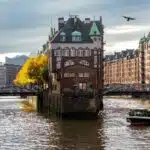Perched on a rugged hill in Bavaria, Neuschwanstein Castle is one of the most famous castles in the world. Known as the inspiration for Disney’s Cinderella Castle, this 19th-century masterpiece was commissioned by King Ludwig II of Bavaria as a romantic retreat. Surrounded by the stunning Alps and overlooking picturesque valleys, Neuschwanstein is a dreamlike destination that attracts millions of visitors each year.
The History of Neuschwanstein Castle
Neuschwanstein Castle was envisioned by King Ludwig II as a personal sanctuary and an homage to the operatic works of composer Richard Wagner. Built in the late 19th century, it was a modern construction for its time, with advanced plumbing, heating systems, and even an early version of a telephone. Despite its grandeur, the castle was never fully completed, as Ludwig passed away under mysterious circumstances in 1886. Today, it stands as a testament to his love for art, mythology, and romanticism.

Highlights of Neuschwanstein Castle
The Interior of the Castle
The interiors of Neuschwanstein Castle are as opulent as its exterior. Highlights include the Throne Room, inspired by Byzantine architecture, and the Singer’s Hall, which is adorned with murals depicting scenes from Wagner’s operas. The king’s bedroom is another marvel, featuring intricate woodwork and a breathtaking view of the surrounding mountains.
The Marienbrücke (Mary’s Bridge)
For the best views of Neuschwanstein Castle, head to the Marienbrücke, a bridge spanning a dramatic gorge near the castle. From here, visitors can capture iconic photos of the castle with its Alpine backdrop. The bridge itself is an experience, offering a thrilling perspective of the steep cliffs and waterfalls below.
Hohenschwangau Castle
Just a short distance from Neuschwanstein is Hohenschwangau Castle, where King Ludwig II spent his childhood. This yellow-hued castle, surrounded by serene lakes, offers a fascinating contrast to the grandeur of Neuschwanstein and provides deeper insights into Ludwig’s life.
Scenic Surroundings
Neuschwanstein’s location is as captivating as the castle itself. The nearby Alpsee Lake is perfect for a peaceful stroll, while the surrounding forests and mountains offer opportunities for hiking and exploration. In winter, the snow-covered landscape transforms the area into a true fairytale setting.

How to Get to Neuschwanstein Castle
Neuschwanstein Castle is located near the village of Hohenschwangau in Bavaria, and it is easily accessible from major cities. The closest train station is in Füssen, about 4 km away. From Füssen, buses or taxis can take you to the village of Hohenschwangau, where the castle is located. Visitors can then either hike up the hill to the castle (a 30-minute walk) or take a shuttle bus or horse-drawn carriage. Driving is also an option, with parking available near the base of the castle. For those visiting from Munich, organized day tours are a convenient way to explore Neuschwanstein and its surroundings.
Tips for Visiting Neuschwanstein Castle
- Book Tickets in Advance: Due to its popularity, entry tickets often sell out. Reserve your spot online well in advance to avoid long waits or disappointment.
- Wear Comfortable Shoes: The hike to the castle and nearby attractions involves steep and uneven terrain.
- Visit Early or Late: For fewer crowds, plan your visit early in the morning or later in the afternoon.
- Enjoy the Views: Take your time on the Marienbrücke for the best photos, but be prepared for crowds during peak hours.
- Explore Beyond the Castle: The nearby town of Füssen and the surrounding Bavarian Alps are worth exploring for their charming streets and natural beauty.
Neuschwanstein Castle is more than just a stunning structure. It’s a journey into the imagination of a visionary king and a celebration of Bavaria’s natural beauty. Whether you’re admiring its grandeur from afar or exploring its lavish interiors, Neuschwanstein is a destination that feels straight out of a fairytale.










